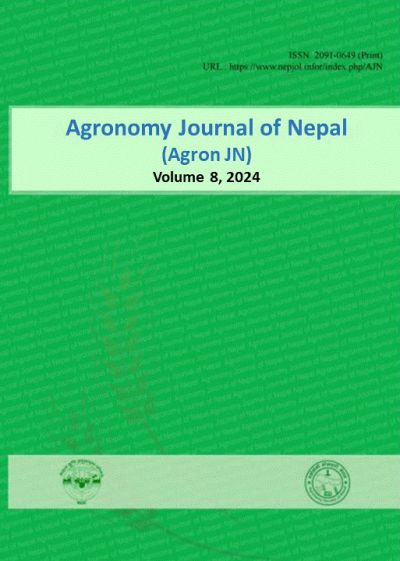Response of Spring Rice Varieties to Different Nitrogen Management Practices in Kapilvastu, Nepal
DOI:
https://doi.org/10.3126/ajn.v8i1.70853Keywords:
Farmer’s Fertilizer Practices, Leaf Color Chart (LCC), Grain yield, Split nitrogen applicationAbstract
The study was carried out at the farmer’s field in Tilkahana, Kapilvastu from February 2020 – June 2020. The objectives of the study were determining the better variety nitrogen management practices for spring rice cultivation. The study was conducted in Factorial Randomized Complete Block Design replicated thrice. Factor A includes spring rice varieties viz. Chaite-5 and Hardinath-3. Factor B includes the nitrogen management practices adopted which were: Recommended dose of N at 3 equal splits, 1/3 at basal +1/3 at 20 DAT + 1/3 at 45 DAT; Recommended dose of N at 3 splits, ¼ at basal + ½ at 20 DAT + ¼ at 45 DAT; N application using leaf color chart (LCC); Zero N, Control and Farmer’s Fertilizer Practices (FFP). Rice seedlings were raised in a wet nursery bed and transplanted in experimental plots on 21st March 2020. The crop geometry was 20 x 20 cm. Growth parameters, grain yield, and yield-attributing traits of rice were recorded. The results revealed statistical differences between the treatments in terms of agronomical parameters, yield attributing characters, and grain yield. Results indicate the recommended dose of N application at 3 splits i.e., ¼ at basal+ ½ at 20DAT+ ¼ at 45 DAT contributes to the higher plant height (104.79 cm), the number of tillers (9.88), grain yield (4.9 Mt ha-1) and straw yield (7.44 Mt ha-1). The highest LAI (2.84), flag leaf length (31.063 cm), and effective tillers/m2 (245.41) were obtained in nitrogen application using LCC. Moreover, the recommended dose of N at 3 splits, ¼ at basal + ½ at 20 DAT + ¼ at 45 DAT, and nitrogen application using LCC showed almost similar performance in most of the parameters. Among the varieties, Hardinath 3 produced the highest plant height (100.86 cm), Flag leaf length (29.509 cm), and 1000 grain weight (29.059 gm) as compared to Chaite 5 (94.613 cm), (26.355 cm) and (24.199 g) respectively. Also, there was a positive correlation between the grain yield and effective tillers per m2 (r =0.972), grain yield and filled grains per panicle (r =0.405), and grain yield and LAI (r =0.716). Hence, the recommended dose of nitrogen application at 3 splits i.e., ¼ at basal+ ½ at 20 DAT+ ¼ at 45 DAT, and nitrogen application using LCC were found to improve yield and yield attributes of spring rice.
Downloads
Downloads
Published
How to Cite
Issue
Section
License
Copyright (c) 2024 Agronomy Society of Nepal (ASoN)

This work is licensed under a Creative Commons Attribution-NonCommercial 4.0 International License.
ASON permits for free use, distribution and reproduction in any medium if the original work is properly cited and not used for commercial purposes.




